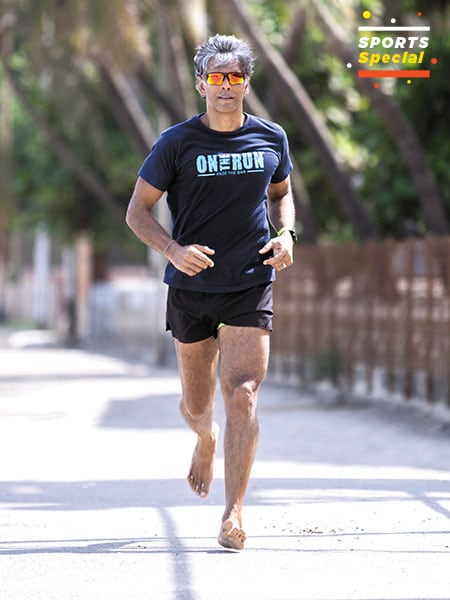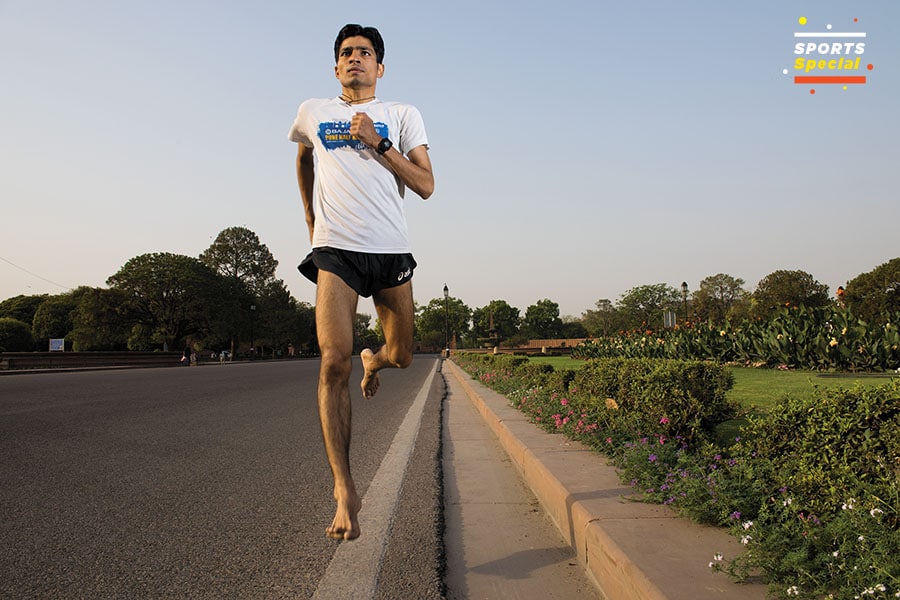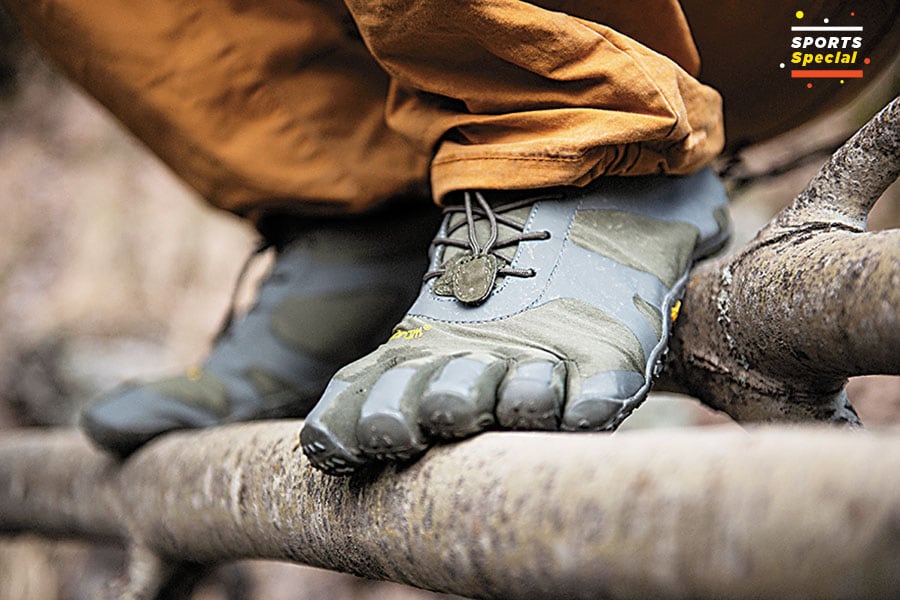
Barefoot running: How Nike and other shoe companies are taking it on
A small but growing group of Indians is ditching shoes to follow a global movement. How is the billion-dollar sneakers industry reacting to this crusade?
 Milind Soman took to barefoot running nine years ago
Milind Soman took to barefoot running nine years agoImage: Aditi Tailang
Marketing consultant Nikki Gupta, 28, was an outdoors person but never a runner. She signed up to do the Chadar trek—a winter trail in Ladakh—two years ago, and was told she should be able to run five kilometres in 15 minutes to be fit enough. Through the process, she discovered a penchant for running and, quite by accident, for barefoot running.
“The trek went really well and I eventually began to run with various running groups back in Mumbai, with clear speed-distance goals,” she says. “I had reached a point where I could do a kilometre in 6.30 minutes, but in January, I found that my pace had dropped to 7.30, and it wasn’t improving. I had begun to find my shoes uncomfortable, feeling trapped in them.”
On a whim, Gupta decided to drop the shoes for a quick round barefoot. “I felt liberated,” she says. “I haven’t gone back to wearing running shoes since.”
Gupta’s story echoes that of athlete-actor Milind Soman, who, since he discovered the freedom of running without shoes nine years ago, has become an ambassador of sorts for barefoot running.
“On one particular run all those years ago, I had done about 20 km, and my feet were beginning to feel really constricted,” he recalls. “I took off my shoes for the last mile and ran in just my socks. Surprisingly, even after running the distance, I felt refreshed. I wanted to explore that further.”
A small but burgeoning group of runners in India is following suit, even in cities like Mumbai, where the terrain is mostly concrete and the quality of roads and cleanliness questionable. This is in line with a global trend, spiked by a popular 2009 book, Born to Run, written by American author and journalist Christopher McDougall. The book investigates the lifestyle of the Mexican Tarahumara tribe, now famous for its long-distance running ability and endurance. The tribe, hailed as ‘superathletes’, runs mostly barefoot, and uses minimal sandals even for the roughest terrain.
In the book, McDougall studies this method and makes a compelling case that “running shoes may be the most destructive force to ever hit the human foot”. McDougall liberally cites the research of Harvard University’s Dr Daniel Liberman, professor of biological anthropology, who says, “A lot of foot and knee injuries currently plaguing us are caused by people running with shoes that actually make our feet weak, cause us to overpronate (ankle rotation) and give us knee problems. Until 1972, when the modern athletic shoe was invented by Nike, people ran in very thin-soled shoes, had strong feet and had a much lower incidence of knee injuries.”

The book also cites, among other researchers, Gerard Hartmann, an Irish physical therapist who works with some of the world’s finest distance runners. Hartmann, who has studied orthotics for decades, says the foot is designed to naturally pronate. “Recent research has shown stability shoes are unlikely to relieve plantar fasciitis [heel pain, common among runners] and may even exacerbate the symptoms,” he says. He asks readers to consider the architecture of the foot, of which the arch is “the centrepiece”. Any arch, he adds, gets stronger under stress: The harder you push it down, the tighter its parts mesh. No one would put a support under an arch, pushing it up from underneath and weakening its structure. “Putting your feet in shoes is similar to putting them in a plaster cast,” he says. With shoes on to do the work, your tendons stiffen and muscles shrivel.
“Buttressing the foot’s arch from all sides is a high-tensile web of 26 bones, 33 joints, 12 rubbery tendons and 18 muscles, all stretching and flexing like an earthquake-resistant suspension bridge,” he adds.
Other medical studies cited in the book conclude that in the more expensive shoes—which usually means more cushioning—the rate of injury, surprisingly, is more, too. Multiple studies have corroborated this data, according to McDougall.
If the shoe doesn’t fit…
A big portion of runners who have stumbled upon this style of running are those with flat feet or other biological issues that running shoes are not often customised for.
Bengaluru-based Ajay Reddy, founder, GoHeritage Run, which organises marathons in India, is flat-footed. He started to experience shin pain after running his first couple of marathons around 2010. “After consulting a doctor who was himself a runner, I bought shoes that were meant to provide medium arch support,” he says. “When that didn’t help, I moved to running barefoot. My logic was that if spending so much money on shoes that are meant to be right for me isn’t helping, why bother.”
He sees a drastic change in the way he runs—his form, landing pattern and awareness have turned for the better.
 Shashwat Shukla has set a world record in barefoot running
Shashwat Shukla has set a world record in barefoot runningImage: Amit Verma
Shashwat Shukla, a final-year law student who set a world record in March—15 km in 58 minutes and 12 seconds, the fastest barefoot 15K—did so with a twisted leg. He hails from Chandrapur, a town near Nagpur in Maharashtra, and comes from poor means. Shukla grew up running competitively at school, participating in national level competitions in his teens, until his left leg became crooked below the knee. He could barely walk, and struggled to perform daily tasks. During the period, his mental health was severely affected, and battling issues on the personal front too, he became suicidal. “I had lost everything in that phase,” he recalls. “But I retained a passion for running, which I couldn’t fulfil.”
In the seven years that he couldn’t run, Shukla became a flute teacher by day and battled insomnia by night. He has scars of cuts from trying to kill himself. Luck brought him back to his old coach, Ram Singh Yadav, a marathoner who represented India at the 2012 Summer Olympics in London. Yadav advised him to try running barefoot.
“I wanted to run again, and my left foot doesn’t rotate much. In shoes, it’s useless,” he says. “My trainer focussed on developing my stride, and as my body adjusted, I could run again. Slowly, I worked on my speed and distance. Now, I’m targeting two more world records and have been approached by various film directors.”
Big strides
Barefoot runners see big changes in the way they run, but it does take some getting used to. Soman says, “Even today, I feel like I’m learning how to run through my feet. In the beginning, the soles are sensitive. Your hands and feet have evolved to feel the environment, and respond. When your body’s responses are faster than thought, and you insulate those responses, it’s like using your phone with gloves on. You can’t do anything with your hands if you wear gloves. Your sensitivity is compromised by 80 percent. The hands and feet are meant to sensitise you to the environment.”
“I’ve been wearing footwear all my life, so it was difficult to get used to that sensitivity,” he adds. “When you start running barefoot, your nerves recede and the skin becomes microns thicker. The body has to remain malleable and adjust its sensitivity, but become more aware. There’s a difference between sensitivity and awareness, which affects how your body responds to the surface. Balance, posture, coordination—you don’t have to think about them. Your feet will tell you, and it will adjust itself to different surfaces. You learn to listen to your body. That’s what I’ve discovered.”
Gupta concurs. “It’s difficult to get used to, and you could get blisters initially while you learn, but I find that I can keep going for much longer,” she says. “You feel connected to the ground, and the kind of grip it gives you is unparalleled. Automatically, your body corrects its form and posture. I can’t wait to do a marathon like this.”
Is it really good advice for runners in cities like Mumbai?
“There’s no such thing as a ‘city like Mumbai’,” says Soman. “I’ve run barefoot in cities across the world, and they’re all the same. Parts of Mumbai are filthy, as are parts of New York. They all have concrete surfaces. I’ve never had any injury in these nine years—you might have a small splinter or a piece of wire pierce you, but that’s only in the top layer of the skin, easy to pull out—it won’t even bleed. The key is to be aware, and listen to the signals your feet send you.”
Soman has two pieces of advice for runners attempting to switch to barefoot: Don’t go too fast, and don’t run too far.
Running on hype?
Globally, the athletic footwear market is expected to be worth $94.15 billion by 2025, according to a 2018 report by Grand View Research, an India and US-based market research and consulting company. During this forecast period, it is expected to progress at a compound annual growth rate of 5.1 percent.
As sneakers straddle the worlds of both athletics and fashion, spotted on top athletes, runways and at sporting events across the world, can barefoot running realistically claim a portion of the market?
As the voices around this movement come together, and get louder, shoe companies have had mixed reactions.
“That trend seems to pop up every five or six years,” Kevin Plank, founder and CEO of sportswear company Under Armour, told Forbes India recently. “The last time it happened, we hosted a marathon in our home city of Baltimore, and I watched people run by in flipper-like shoes. I don’t get it,” he says. “I’ve read the book, I understand the science, but running on concrete with nothing on your feet? God may have thought he wanted us to run barefoot at some level, but I’m really glad that we made shoes. I’m glad there is technology between me and god’s great earth that I can walk on every day, giving me cushioning and strength. I don’t know—I wish the movement luck, but I’m set for a safer and more comfortable ride.”
Nike, which takes a lot of the credit for creating the modern athletic shoe—and the brickbats too—has invested in some research and development in this area. While a Nike spokesperson was unavailable to comment, the communications team linked us to a blogpost that Nike has written about this, on the ‘Nike Free’ footwear range.
According to the post, “Nike designers saw Stanford University runners cooling down barefoot on the grass infield of the school’s track (their coach thought this improved foot health). It piqued their curiosity, so they dug into the science of it. What they learned, after studying the bare foot in motion on grass for more than a year, was surprising: Immediately, the foot had a more natural foot strike and flexed more, and, over time, runners reaped benefits such as more foot flexibility, better balance and improved strength.”
Nike attempted to replicate the bare foot with first a “super-minimal bootie-like prototype” for these athletes, protecting against sticks and pebbles but also letting the foot move naturally. Not initially made for commercial purposes, as per the post, “a few people at Nike saw great opportunity in it”. The first edition of the Nike Free shoes was released in 2004, and the line was revised in 2014 to revamp the outsole design. The 2019 edition, released in March, is closer to the 2004 model “to promote a more barefoot-like feel underfoot”, with midsole siping (slits made on rubber) along the top and bottom to allow greater flexibility. The “minimal uppers”, says Nike, are designed to enhance a “second-skin” feel.
Nike Free is designed for low-mileage runs. Puma, on the other hand, says they experimented with a minimalist product called Speed 100 to cater to this market. “However, our experience says that the real trend is somewhere else,” says Abhishek Ganguly, managing director, Puma India. “Our running consumers are preferring footwear that provides more cushioning and responsiveness. Our most popular running footwear currently has the Hybrid technology, which provides both of these features in the same product.”
The Hybrid technology offers a deconstructed shoe, which, says Puma, has a heel-to-toe drop of 8 mm and a sole height of 12 to 20 mm; for a minimalistic running footwear these would be zero and a maximum 10 mm respectively. “The Hybrid has been so successful that we have incorporated the technology now in our other footwear ranges beyond running,” says Ganguly.

Perhaps the best known name in the barefoot shoe space is one that isn’t famous for its big-ticket endorsers or its wide range of sportswear. Vibram, an Italian company that manufactures vulcanised rubber outsoles, also makes the Vibram FiveFingers—a shoe that slips on to your foot like a glove, with separators for toes, to allow them to move freely and separately.
“We’re the first and only ones who offer a product with five toes. All the other products, even into the minimalist market, are without the toes. For sure, this can be a reason for loving us or not, but it makes us unique in the shoe business: Without any real competitor,” says Davide Canciani, global marketing director, Vibram. “Vibram created a whole new segment in the market, teaching people how to go back to human nature, feeling the ground. While many larger shoe brands have created a minimalist shoe, they cannot compete with the true Vibram FiveFingers barefoot experience, and have since left the market.”
Seeing potential with a growing number of Vibram FiveFingers users in Asia, Canciani says the company plans to expand its footprint in the region. “Vibram FiveFingers is not a product for running only, but a natural training tool that can be used to train for various sport activities, from mountain climbing to gym training and for water sports,” he adds. “Vibram’s mission is to create the best soles on earth and also innovative footwear where soling is the central component.”
Many barefoot running advocates use the Vibram FiveFingers, either as an extra layer of protection on their daily runs, or for special terrain where running barefoot could prove challenging.
“They don’t have an upper like other shoes, so don’t make your foot feel trapped,” says Soman. “I use them in the rains, to avoid wet feet—which causes your soles to become softer, and therefore, more susceptible to cuts. I also use them in extreme heat, when running from city to city, when I need something on the sole. But I typically cut through the toes so my feet have more freedom.”
(This story appears in the 07 June, 2019 issue of Forbes India. To visit our Archives, click here.)


















